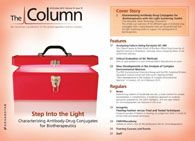Handmade Sea Salt Markers
A new study to be published in the journal Food Chemistry proposes 10 compounds that could be used to determine the authenticity of handmade sea salt opposed to industrial sea salt.
A new study to be published in the journal Food Chemistry proposes 10 compounds that could be used to determine the authenticity of handmade sea salt opposed to industrial sea salt.1
Sea salt is a handmade food product that is formed by the evaporation of sea water in salt pans. Prior to evaporation, the sea water passes through ponds of increasing salinity incorporating volatile compounds from the environment. According to Sílva M. Rocha, corresponding author of the paper, there is a growing interest to protect handmade sea salt because it is a highly valued product. She told The Column: “Volatile components present in sea salt could play an important role in differentiating this handmade food product from industrial salt, and valuing sea
salt as a distinct and desirable product.”
The authors collected samples from seven locations around the north-east Atlantic Ocean, including France, Portugal, Spain, Canary Islands, and Cape Verde. The samples were then analyzed by headspace solid-phase microextraction coupled with comprehensive two-dimensional gas chromatography to identify 32–71 compounds per salt, of which 10 compounds were found in all samples. Sílva told The Column: “Our study shows that volatile markers of sea salt could play an important role in the definition of this handmade food product, and so add to the value of sea salt as a distinct and desirable product. A more extensive study should be conducted including samples collected across the world’s oceans.” — B.D.
Reference
1. Isabel Silva et al., Food Chemistry169, 102–113 (2015).
This story originally appeared in The Column. Click here to view that issue.

University of Rouen-Normandy Scientists Explore Eco-Friendly Sampling Approach for GC-HRMS
April 17th 2025Root exudates—substances secreted by living plant roots—are challenging to sample, as they are typically extracted using artificial devices and can vary widely in both quantity and composition across plant species.
Thermodynamic Insights into Organic Solvent Extraction for Chemical Analysis of Medical Devices
April 16th 2025A new study, published by a researcher from Chemical Characterization Solutions in Minnesota, explored a new approach for sample preparation for the chemical characterization of medical devices.













